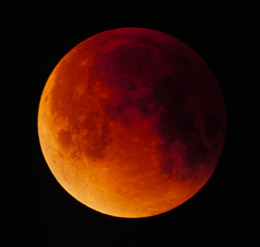A
Total
Solar Eclipse and a
Total
Lunar Eclipse are rare and very dramatic events. Even
if these eclipses are partial, it is still worth a
look. An eclipse occurs when the
Moon comes between
the
Earth and the
Sun (Solar Eclipse), and when the
Earth comes
between the
Sun and
Moon (Lunar Eclipse).
Because the Moon is much smaller than the Earth, Solar Eclipses are more rare to a specific area on Earth because of the shadow produced by the Moon is small compared to the shadow made by the Earth during a Lunar Eclipse.
For
Solar Eclipse dates and times, click
here.
 |
A
Total Solar Eclipse like this one is an unforgettable sight.
Please visit the
Solar Viewing Safety page for details on how to
safely view this wonderful phenomenon.
One of the effects of a Solar Eclipse is a marked decrease in overall sunlight in the region where the eclipse is occurring. To me, this is as dramatic as the eclipse itself. |
Going outside during an eclipse is encouraged - please enjoy this rare event!
For
Lunar Eclipse dates and times, click
here.
 |
A
Lunar Eclipse with the traditional
copper appearance is seen here. Only a total lunar
eclipse will look this dramatic. The color
is the result of red light refracted from
sunlight through
Earth's atmosphere.
It is
perfectly safe to view a
Lunar Eclipse - and
it is certainly safe to go outside when a
Lunar Eclipse is occurring. |
This wonderful image is care of the Grasslands Observatory:

Back to Top |

